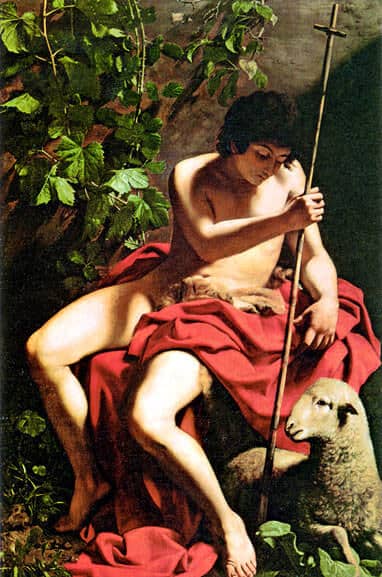John the Baptist, 1598 - by Caravaggio

Although at one time this picture was thought to be by the Viterbese painter, Bartolomeo Cavarozzi, who spent some time in Spain (1617-c. 1619), several scholars have recently supported the old attribution to Caravaggio. A. E. Perez Sanchez argues that, while the figure of the youthful St. John has certain affinities with Cavarozzi's style, the rest of the picture does not, and the extremely high quality of certain passages, especially the beautifully depicted vine leaves, so strongly reminiscent of the Ambrosiana Basket of Fruit, is much more characteristic of Caravaggio. The delicate treatment of features and contours is also close to that of early paintings by Caravaggio, as is the gentle chiaroscuro. Such a dating on stylistic grounds, together with the work's Spanish provenance, leads one to speculate whether this, in fact, may not have been one of those pictures which, according to Mancini, Caravaggio painted for the Prior of the Hospital of the Consolazione, where he had been undergoing treatment sometime in the early or mid-1590s: 'He soon fell ill with a serious illness and; being without money, he was forced to go to the Hospital of the Consolazione, where, during his convalescence, he made many pictures for the Prior, who afterwards took them with him to his homeland, Seville.' The problem is somewhat complicated by the fact that one manuscript version of Mancini's Considerazioni sulla pittura reads 'Siviglia' ['Seville'], another 'Cicilia' ['Sicily']. It has been demonstrated by Luigi Salerno (1955) that there was in 1593 a Spanish prior of the hospital, Camillo Contreras, and that he may have remained prior until June 1595, when a new prior is referred to in a document. Frommel has found evidence which casts doubt on Salerno's finding, but does not, to my mind, invalidate it. The presence of paintings by Caravaggio in Seville at an early date is an important issue in that such works may have influenced the young Diego Velazquez in his early bodegones painted in the late part of the second decade of the seventeenth century. The word bodegones has come to refer to still-lifes, or genre scenes including still-lifes, but Velazquez's were usually religious scenes presented in a genre idiom with still-life details.
















